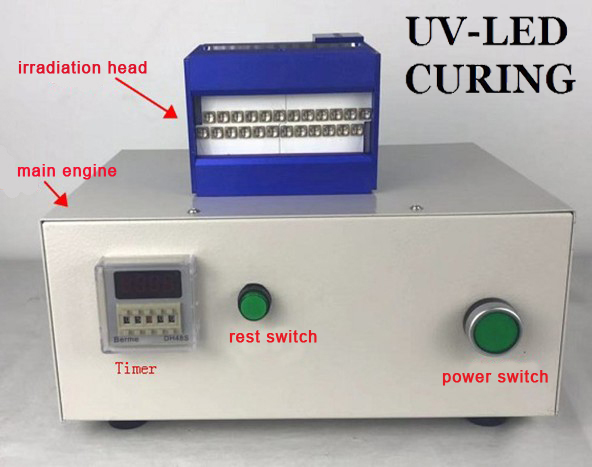The Advantages of UV LED:
Since 2014, most domestic manufacturers still use the traditional UV mercury lamp to work, but UV Light Source will eventually replace the mercury lamp, because its advantages are much larger than the traditional mercury lamp.
1.Ultra long life : the service life is more than 10times of the traditional mercury lamp curing machine, about 25,000~30,000 hours.
2.Cold light source, no heat radiation, low temperature rise on the surface of illuminated products, solving the long-term thermal damage problems in optical communication and liquid crystal production. Especially suitable for liquid crystal edge sealing, thin printing and other occasions requiring small temperature rise.
3.Low calorific value, can solve the problem of high calorific value of mercury lamp spraying equipment and unbearable for the staff.
4.Instant lighting, no need to warm up immediately reach 100% power UV output.
5.Service life is not affected by the number of open and close.
6.High energy, stable light output, uniform irradiation effect, improve production efficiency.
7.Effective irradiation areas can be customized, ranging in length from 200mm to 1000mm.
8.Mercury free and ozone free, it is a safer and more environmentally friendly alternative to traditional light source technology.
9.Low energy consumption, power consumption is only 10% of the traditional mercury lamp curing machine, can save 90% of electricity.
10.Maintenance cost is almost zero, the use of UV LED curing equipment saves least 10,000 yuan/set of consumable costs every year
What kind of Technical Research in Ultraviolet LED :
In addition, the research and development of ultra-violet LED encapsulation with high optical efficiency and reliability, the titanium oxide device of ultra-violet LED and the photocatalytic degradation of methylene blue to to treat organic waste-water were also deeply studied in China.
Overseas, the Japanese sub-chemical industry has developed a set of ultraviolet light-emitting diodes with light wavelength of 365nm and luminous power of 10mW. In 2008, the institute of science and chemistry and panasonic electrician announced that InAIGaN, which uses GaN semiconductor, has developed a LED with 282nm as the central wavelength of light emitting and 10mW as the output power of light. In the terms of dark ultraviolet LED with shorter wavelength, NTT institute of fundamental physical science has developed a dark ultraviolet LED with 210nm central wavelength by using AIN material. PPM modulation is suitable for the study of LED-based ultraviolet communication modulation.
The latest technological developments are extending parts of the UV LED market to new new heights of product innovation and performance. The next generation of ultraviolet LED technology has five important advantages :
1.Increase the life of
Before 2008, the usage rate of ultraviolet LED decreased significantly. This is because ultraviolet light beam is easy to decompose epoxy resin of LED, thus reducing the life of Ultraviolet LED to less than 5000 hours. The next generation of UV LED, which feature “hardened” or “UV resistant” epoxy packages, will provide a life span of 10111 hours, but still fall far short of most applications. In the past few months, new technologies have addressed this engineering challenge. For example, Lumex’s new QuasarBrite ultraviolet LED technology (figure 1) uses a robust TO-46 package with a glass lens to replace the epoxy lens, extending its service time at least tenfold to 50000 hours.
2.Efficiency
The output power of ultraviolet LED is only 5-8% of the input power. When the wavelength is 385nm and above, the efficiency of ultraviolet LED is improved, but only 15% of the input power. As emerging technologies continue to solve efficiency problems, more applications will begin to adopt ultraviolet LED technology.
3.Environment Benefit
UV LED use 70% less energy than fluorescent ones. In addition, UV LED do not contain mercury, a harmful substance commonly found in CCFL technology. Because ultraviolet LED has anti-vibration and impact resistance, damage is rare, thus reducing waste and cost.
4.Performance
Ultraviolet LED provides a smaller beam angle and a uniform beam. UV LED cost less than half as much as CCFL technology because they do not require other lenses to achieve compact beam angles and uniform beam patterns, have lower energy consumption and increase durability.
5.Extensive Applications
UV LED current uses includes : optical sensors and instruments (230-400nm), ultraviolet (UV) authentication, barcode (230-280nm), surface water sterilization (240-280nm), identification and detection and analysis of fluid (250-405nm), protein analysis and drug invention (270-300nm), medicine, light therapy (300-320nm), polymer and in printing (300-365nm), false infentification, surface sterilization / cosmetic sterilization (390-410nm).
What are the Applications in UV LED Photocuring:
1.Microelectronics industry UV LED photocuring application
2.PCB industry UV LED photocuring application
3.Medical device UV LED photocuring application
4.Optical industry - ST - LED UV curing applications
5.UV LED curing application in optical communication industry
6.Research institute -ST - LED UV curing application
7.Printing UV ink curing
